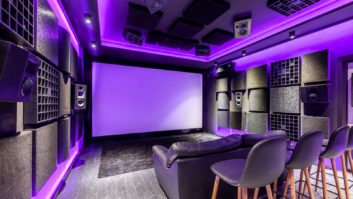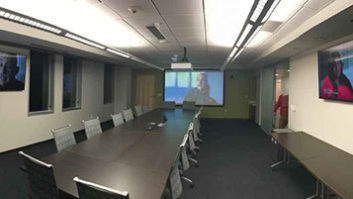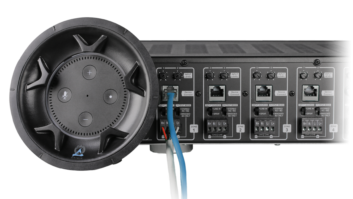
Texas-based integrators iEvolve Technology, whose work is about 80 percent residential, outfitted the 80,000-square-foot office of Omni Flow Computers with a control system from RTI. Thanks to an improving housing market and rebounding economy, the demand for high-end residential integration is about as strong as it ever has been. In many regions, the only thing limiting success is the ability to hire enough help to keep up with the volume of work. Even so, it can never hurt to take a look at the other side of integration–the commercial world–to add diversity to your portfolio. According to some residential integrators, crossing over into commercial can be easier (and more enjoyable) than you might expect.
For many, the transition begins with a request from a past client. Tom Stone, founding principal of Stone Glidden in King of Prussia, PA, first got into light commercial at the behest of clients for whom his firm had done residential work, and wanted the same kind of AV integration in businesses they owned. Stone said that restaurants and boardrooms are easy stepping-stones.
“Conventional restaurants need music,” he said. “They need networking, and when they see what lighting control can do, they’re pretty interested, assuming it’s in their budget.” For boardrooms, he said it’s also quite easy to leverage residential experience. “Boardrooms are a piece of cake compared to what we normally do, with a few exceptions. You have to be careful about videoconferencing, and whiteboards are closely guarded turf by the commercial integrators.”
Other integrators, like Peter Shipp, principal at Orlando, FL-based ZIO Group, eschew light commercial work because of its low profit margins and tendency to underemphasize quality. Seeing opportunities in full-scale commercial, Shipp’s team brought in partners from outside the industry to begin building relationships in the construction and design community. “In the commercial world, when something doesn’t work the first time, they go looking for something better,” Shipp said. “So there’s much more propensity to spend money and get newer and better technology than they did the first time.” He said that commercial operators put much more focus on high technology, whereas restaurants and bars tend to opt for the cheapest solution.
Heather Sidorowicz, president and owner of Southtown Audio Video in Hamburg, NY, also started out in residential integration but found a commercial niche in higher education, as well as in the large-scale redevelopment of downtown Buffalo, NY.
“We’ve done a lot of work at the local university [State University of New York at Buffalo]: athletics facilities, coaches’ offices, TVs that connect to computers for game-day information, university-wide digital signage,” Sidorowicz said. “Also, music throughout dining facilities; that’s been a great market, where we’ve added a few on each year.”
According to Sidorowicz, commercial work isn’t as personal; but sometimes she prefers it that way. “The pro of it not being personal is the dollar sign–it’s not about fighting over every dollar,” she said. “Once [commercial clients] understand and expect that you will treat them fairly and price-match, they’re not going to come at you each time.”
Stone also prefers negotiating with professional point people. “Let’s say they had a budget and you have to bring the budget down and do it by maybe giving them a less attractive control solution, they understand. They say ‘OK, that’s the tradeoff,’” he said. In addition, the set timelines that almost always accompany a commercial project add comfort. “I found that the jobs go in a little quicker, on a tighter timeline than residential, so that’s nice, when you can count on a certain portion of a project being done in a certain month,” he said. “Versus residential, which can drag on, and drag on, and drag on.”
While commercial integration may be more efficient work, many integrators, like Mike Roberts, owner of Houston, TX-based iEvolve Technology, nevertheless relish the feeling of completing residential jobs for at least one reason: the sight of a satisfied customer.
“My favorite part of what I do is giving an orientation and seeing the clients light up with excitement when you demo the first real action scene in their new home theater, or showing them the level of control they now have with their home,” he said. “With a commercial project, there isn’t as much interaction with the client, and rarely on a personal level. The best you get is generally ‘well, that was easy!’”
Often times, though, venturing into the commercial sphere isn’t so easy. “You better be sure that you’re paying attention to local codes and OSHA rules,” Sidorowicz warned. “You have to learn a whole new ballgame; you can’t just jump into it with both feet. You really have to take a step back, take some classes, go to InfoComm before you jump in.”
Shipp said that his company hires engineers specifically for commercial projects, because regulations and equipment involved in large-scale commercial can be so different. “Audio and control is the big difference,” he said. “There really is no overlap in products that you use for commercial sound, especially in digital signal processors. The programming of DSPs is very much like AMX and Crestron control, where out of the box they do nothing, and you have to tell it what you want it to do. So you have to have someone that’s trained, and almost all those vendors that we work with– Biamp and QSC–they require you to have on-staff programmers that have been to training, and they enforce it.”
Like Shipp, Roberts had a lot of new products to get used to on the commercial side: videoconferencing, video walls, wireless presentation systems, microphone systems, digital signage, and 70V distributed audio. One familiar residential brand he found to be very useful in the commercial sphere is RTI, which he and his company used to create a custom control solution at the Sugar Land, TX, headquarters of Omni Flow Computers, one of the largest providers of specialized computer systems to the oil and gas industry. For this 80,000-square-foot space, the RTI XP-8s control processor provided a powerful and intuitive system for the entire facility. “By creating custom-made interfaces with RTI’s programming software, we easily tailored the user interface to enable staff members to operate any facet of the system,” he said.
Patrick Hartman, AV operations manager at Diversified Systems International in Reno, NV, came into commercial work 12 years ago after more than a decade of residential work. And though he said residential is in his blood, he finds commercial work is much more easy to manage. “In residential, there’s more profit margin in the equipment, but what makes or breaks that is the managing of the project,” he said. “I’ve had residential jobs that have lasted two to five years, so it’s a struggle financially in the high-end residential world.”
Hartman said the main difference is that in commercial, most of the time the scope of the project is spelled out beforehand, so the work can be completed on a much tighter and more predictable schedule than a full home build out. “And we’re not integrating as many disciplines in the commercial world as we are in residential,” he said. “In commercial, it might be audiovisual, it might be control, and it might be lighting control, tops. In residential, you’re adding access control, you’re adding security, you’re adding multiple, multiple layers, which adds to the complexity.”
As we’ve seen in the past, the integration business is very much at the mercy of financial climate changes. Breaking out of your comfort zone and plying some of your trade in the commercial sector can prove an invaluable decision when hard times invariably hit. And hey, there’s still a few days left to make a last-minute trip to InfoComm.
Matt Pruznick ([email protected]) is the associate editor of Residential Systems and Systems Contractor News. Follow him on Twitter @Pruznick.





